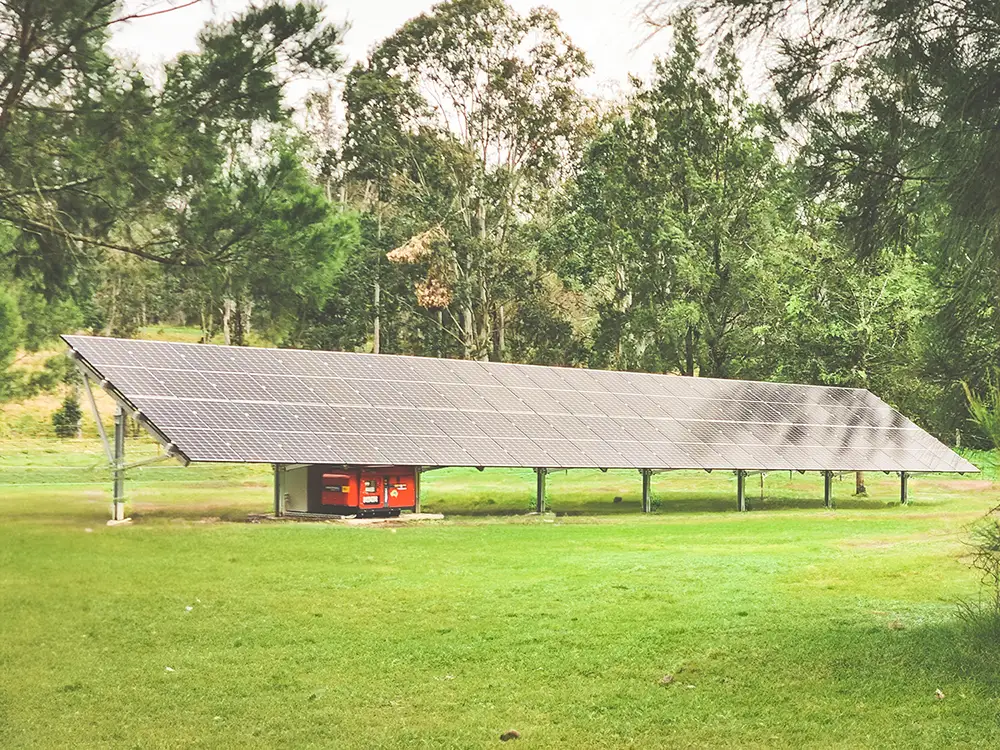The NSW Battery PRDS Incentive is Now Available
The NSW Battery PRDS Incentive is Now Available
Posted 17 Dec
Depending on where you are in Australia, you may be curious to know if a Rooftop or Ground Mount solar system is a better option for your property. Whether you’re a business or a homeowner, both systems have their respective benefits which provide pros and cons for a variety of properties.
We don’t need to talk about what rooftop solar systems are as they’re all around us, but ground mount solar systems are a little less common, at least in NSW where we are.
Ground mounted solar systems are typically solar arrays that are fitted on metal structures that are mounted by poles which are secured into the ground with concrete. These ground mounts can be adjusted in height, tilt, and rotation to best suit the environment and the sun’s direction for optimal exposure.
Similar to a common rooftop solar system, the solar panels are also secured with rails and brackets that hold the panels in place, however, the structure that it is attached to, is not the roof.

As mentioned before, both types of solar systems will have their time to shine in certain circumstances. Here are a few pros and cons
for both Rooftop Solar vs. Ground Mounted solar systems.
|
PROS |
CONS |
|
| Ground Mounted Solar |
|
|
| Rooftop Solar |
|
|
Considering the pros and cons of ground mount solar systems, there are realistic situations where ground mount systems just make more sense to install compared to solar on your roof.
When you’re Off-Grid
If you own a remote property with limited or no access to grid electricity, you’re likely going to need an off-grid system. Not every rooftop will have enough room to fully produce the power you require.
By installing a ground mount system, you can power your home with an expandable system that can also be scaled to your energy requirements, allowing your property to have adequate solar production.
You want Additional Solar but have no more Roof Space
Imagine you maxed out your roof with solar panels, and you love your self-generation so much that you want more. How do you expand your system?
By adding a ground mounted solar system to your property, you can expand your system to what your consumption habits and
energy goals require. Think of it like a mini solar farm for your backyard.
Agrivoltaics is the combination of agriculture and photovoltaics. It’s the coexistence of solar and agricultural farming on the same land to maximise production and benefit each other.
By using ground mounted solar systems on paddocks or large open areas, it not only provides shade for cattle and other animals but can also generate renewable energy to power machines and other consuming devices that contribute to the farms operations. It also minimises water evaporation from the soil which reduces the need for water irrigation.
For example, we visited a chicken farm which uses a high amount of electricity for fans and other equipment for the uptake of the chicken’s wellbeing. This could be further offset with ground mount solar systems and can also add shading for free range chickens.

There are situations where homeowners can’t get solar for on their roof for a few reasons making ground mount the better option.
Your home’s roof structure may not be strong enough to support the weight of a solar system. Some older homes may have certain deterioration or damage that disallows such a heavy installation.
Your house may be surrounded by trees or other tall buildings which would cover the panels and greatly reduce your production. A ground mount could be a good way to get extended solar exposure.
If your roof faces are facing the wrong way, it may reduce your home’s generation potential. Depending on designs, it may make more financial sense to get a ground mount solar system installed.
With rooftop solar contributing to 11.3% to Australia’s entire electricity generation in the first half of 2024, it is definitely a popular way to start harnessing free energy from the sun.
Here are a few reasons why you should get a rooftop solar system instead of a ground mount system.
Not all solar installers provide ground mounted solar solutions in-house.
By looking into rooftop solar, you instantly gain access to a larger range of installers compared to if you were just looking for solar installers that also do ground mount. (There’s not many of us!)
Because your roof, is well, already there, adding a solar system doesn’t require much in addition to the system itself in terms of the installation. You’re just taking advantage of roof space that would otherwise just sit in the sun and do absolutely nothing.
Most suburban homes don’t have much room for a ground mount system in their backyard. Whilst it is accessible for some, the majority of homes will only need the amount of solar that their roof can fit, if not, less. If you want to add a ground mount system to your backyard, we definitely recommend getting the wife’s approval first!
Considering that both systems use panels and racking, ground mount solar is more expensive due to the additional mounting needed and the corresponding trenching and other works. This extended labour will cost more to install.
If you’re willing to spend that bit more, a ground mounted system will allow you to generate even more solar. They can both also be paired with diesel generators and battery storage.


Depending on your consumption, ground mount solar can definitely be worth it if you have the vacant space to accommodate it.
We have installed a number of ground mount systems, in which most of them were off-grid. Because these properties are completely disconnected from the grid, they need appropriate electricity generation which in this case is solar. By having a large solar system, they can produce more than enough electricity to store in their batteries for later use.
Not every house will have the roof space for a solar system, so having an option to put solar on its own structure is useful!
Overall, we recommend both systems to various homes and businesses who are wanting to find the optimal electricity generation possible. By investing in solar on either your roof or on the ground, you still offset your daily energy usage, and when compared with a battery, completely offset your overall energy consumption with complete renewables.
Our team have extensive experience in designing and installing both rooftop and ground mounted solar solutions for homes and businesses across Newcastle and the Hunter. Our in-house team of expert engineers, designers, and installers can help you find the optimal solution for your property whether you are on or off-grid.
Get expert consultation and quoting for free today and understand how you can make the most out of your energy.

Rooftop and ground mounted solar are ways you can add solar to your home.. but which is better? Compare roof vs. ground solar systems and see what's best.

Explore the NSW battery 'rebate' (Peak Demand Reduction Scheme), approved battery brands, pricing, and how you can be eligible to save on your first battery.

Explore the best home solar batteries from 6kWh, 10kWh, and 15kWh energy capacity options. Protect your solar energy in Newcastle & Hunter NSW.

The journey of bidirectional charging in Australia has hit a milestone with the recent approval of the new standard for vehicle-to-grid (V2G) charging for 2025.

Explore how daylight savings and seasonal changes during winter and summer can affect your solar panels performance and solar generation in NSW, Australia.

Deciding whether to get off-grid solar and battery? Explore the benefits of complete off-grid electricity, and if getting an off the grid energy system is right for you.

Everyone has seen a solar installation a normal roof like tin or tiled roofs, but have you ever seen a solar installation a roof made of Brass? Well we did one...

With the release of the new Clean Energy Council (CEC) H1 2024 report on solar and battery storage, it gives an idea of the upward path of Australia’s renewable energy adoption.

Amber & ARENA have started trials for Vehicle-to-grid technology in NSW, Australia to help develop standards and framework in V2G and Bidirectional charging.

Are you maximising your solar energy production? Explore ways to improve self-consumption, and accelerate returns and benefits in NSW with solar tariffs.

What's the difference between Tesla Powerwall 2 and 3? Lets compare specifications, release dates, features, and compatibility between Powerwalls in Australia.

With the surge in battery adoption in Australia, many are curious to know if home battery storage is safe and if they pose a fire risk. Here are fire statistics..

Investing in your solar system has many opportunities, but should you replace your panels, upgrade with more solar, or add battery storage to your home?

Though bidirectional charging isn't available, vehicle-to-grid is already turning heads in Australia with its potential to change energy consumption and distribution.

Discover the difference between power and energy in electricity and how solar and batteries are measured differently for homes and properties across Australia.

With the uptake of solar and battery systems, Microgrids, Virtual Power Plants, and Distributed energy resources are becoming more apparent. What are they?

To put simply, whilst both are a current of electricity, DC (direct current) only flows in one direction, whilst AC (alternating current) flows both directions.
![How Australia Reached 40% Renewables⚡[Q4 2023 Statistics]](/media/website_posts/74/Sydney.webp)
In the new 2024 CEC report, they found that renewable contribution in the overall supply of energy in Australia, produced 40% of Australia’s total electrical supply.
![Energy Bill Still High Even With Solar?⚡Here's Why.. [2024]](/media/website_posts/73/Solar-panel-home-installation.webp)
Solar owners may be receiving higher energy bills than expected. Why is my bill still high after solar installation? Why are my solar panels not reducing my bill?

Explore the differences between on vs. off peak electricity, the best times to use energy, and the best hour tariffs to get the most out of your energy in NSW.

If you're looking to reinvest in your solar system should you add panels and upgrade, or should you replace the entire system and start fresh? Which is better?
![Single vs. Three Phase: What's the Difference?⚡[Australia]](/media/website_posts/70/Home-solar-installation-energy-electricity.webp)
The difference between single and three phase power in its simplest, is how each phase distributes an electrical load, with 3-phase being higher capacity.

How do you clean solar panels and battery storage? Should you hire an expert or DIY clean? Explore everything you need to know about cleaning your solar.
![Choosing a Solar Installer: [Common Mistakes to Avoid]⚡2024](/media/website_posts/68/Commercial-Industrial-newcastle-solar-and-battery-installers2.webp)
Having trouble finding the best solar installer in your area? Explore some tips and tricks on picking the right solar or battery installer and avoid making mistakes.
![Solar Installations Made Easy: A Step-by-Step Guide⚡[2024]](/media/website_posts/67/Black-solar-panels-system-rooftop-newcastle.webp)
Learn the solar installation step-by-step process of how solar panels are installed, and easily understand each step of installation so you can keep track.
![Solar Rebates & Schemes: What's Available?⚡[NSW] 2024](/media/website_posts/66/Solar-panel-Installation-Newcastle-Installers-thornton-2.webp)
What solar rebates and schemes are available for Australians to take advantage of in 2024? Explore government rebates and schemes in NSW for solar panels.
Leave a Comment